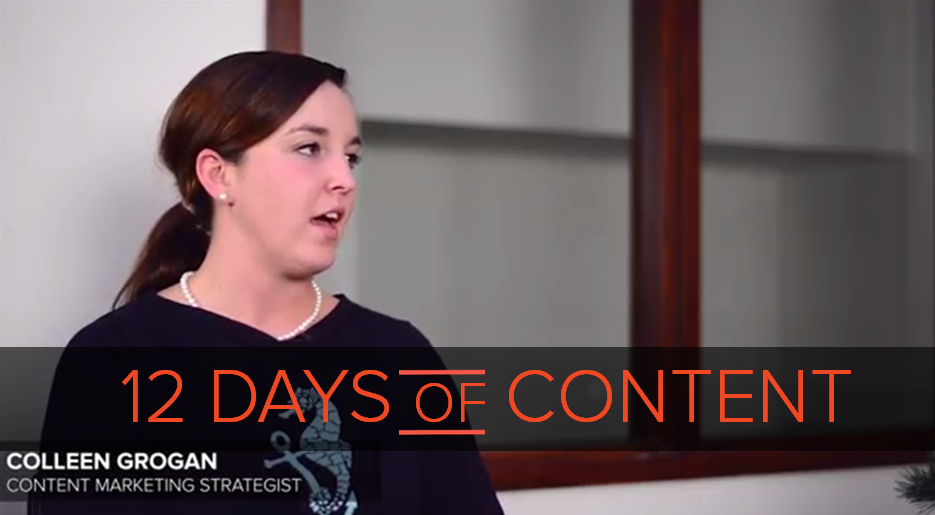You create content to engage customers online, but how can you tell if it’s working – that people read your resources and find them valuable? Producing engaging web content is a top challenge for brands. As well as you know your customers and strive to produce materials that answer their biggest questions, you may not know what’s going to resonate.
On the ninth day of our 12 Days of Content series, we asked content marketing strategist Colleen Grogan to talk about measuring how engaging your content is. Watch her interview, and read the blog post for additional insights:
Measure your content’s engagement through analytics
Look in Google Analytics for engagement metrics to measure how effectively your content is holding readers’ interest and inspiring them to check out additional resources. Engagement metrics give you an idea of whether people think the content is worth spending their time on and making them want to interact with your brand.
- Average time on site
This tells you how long people stay on the site when they click to read your content. A longer visit means prospects are exploring your site beyond the article that brought them there.
- Pages per session
If your content is engaging visitors, you should see that readers are clicking through to multiple pages on your website.
- Bounce Rate
A low bounce rate suggests readers are interested in the information you’re sharing and want to learn more. A high bounce rate can tell you that people weren’t very engaged in your content and left the site after arriving, without taking any further action.
Track viewer engagement with social stats
In addition to the results you monitor in Google Analytics, there are other important social media metrics you should look for:
- Shares
A “Like” or “Favorite” means viewers approve of your content, but a Share or Retweet tells you that they found it so valuable, they wanted other people to see it. It also means your content is reaching wider networks and building your audience.
- Clickthroughs
Going beyond a Like or a Share, review clickthrough metrics. This shows you how many people see your content and click it, demonstrating their active interest in what you shared and desire to read more. People Like a lot of content without necessarily thinking about it. Visits to your website show that they took the next step to read what you have to say and learn about your business.
“The focus should be on clickthrough – and not only to time spent absorbing the blog, but also how they think of your brand after they spend their time reading an article. You should measure how many pages people click on your site after reading that first piece,” Colleen said.
Look for signs your content isn’t engaging readers
There are also some warning signs that indicate your web experience isn’t effectively engaging visitors. According to Colleen, you should look for:
- Increasing bounce rate
- Lower time on site
These are signs people aren’t engaging with your brand after they come to read something. If they don’t see the value in the information you’re sharing, they’re not going to read the article, stay on the page or convert. On the other hand, if they find the content engaging, they’re going to read something else, click through to additional articles and possibly convert.
Create content that’s more engaging for YOUR audience
There’s no silver bullet to engaging content. What works for one audience won’t always work for another, especially if they’re very distinct.
According to Colleen, the most important way to make your content more engaging is to develop “A clear and realistic understanding of your audience – not necessarily your IDEAL audience – your actual daily visitors.”
A lot of companies want CEOs to be reading their blogs, so they create technical, jargon-heavy pieces with that audience in mind. However, their daily readers might actually be admins, managers or directors who have been asked to vet solutions for the company and need a high-level overview to relay to their executives. These readers may need hard-hitting stats as well as exposition to fill in knowledge gaps.
“The focus should be on clickthrough – and not only to time spent absorbing the blog, but also how they think of your brand after they spend their time reading an article.
You should measure how many pages people click on your site after reading that first piece.”
If you see that your visitors are frequently coming from social networks, give them something that adds instant value like a tip-driven article. If they’re conducting in-depth research about a high-ticket subscription service, offer a thoroughly researched resource like a white paper or infographic. And if they’re somewhere in between, try an eBook. It’s a happy medium that’s colorful, with graphic elements and lots of statistics.
As easy way to improve engagement across the board is to break up text with bullet points, lists, pull quotes and graphic elements. Readers are generally more willing to read longer content when there are features that hold their attention, rather than sifting through a wall of text.
A successful content marketing campaign engages the audience and inspires them to read more. If you’re not seeing strong engagement metrics, you should revamp your strategy to better appeal to readers and make the most out of the traffic your content attracts.
To learn more about engaging content strategies:
- Get in touch with a member of our team
- Check out this case study how our client increased its engagement 23 percent
Check back for more answers in our 12 Days of Content!



